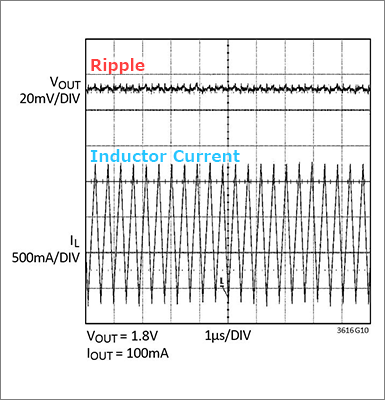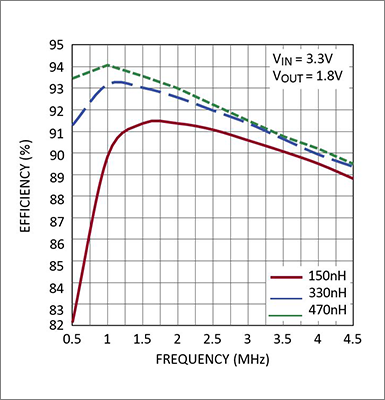リップルを小さくするスイッチング・レギュレーターの最新ソリューションを紹介します。
スイッチング・レギュレーターのリップル電圧の式
デジタル回路が高速信号を扱う場合、ジッターの要求仕様も厳しくなります。そのため、ジッター特性に影響するリップル電圧を小さくする必要があります。今回は、そのジッター特性に影響を与える、スイッチング・レギュレーターのリップルを小さく抑えるために、どの様にすべきかを考えてみます。
VRipple: リップル電圧
ΔIL:インダクターのリップル電流
ESR:出力コンデンサーのESR
fSW:スイッチング周波数
COUT:出力コンデンサーの容量
スイッチング・レギュレーターのリップル電圧は、式1 の様に表すことができます。
この式から、インダクターのリップル電流(ΔIL)が大きくなると、リップルが大きくなることがわかります。
インダクターのリップル電流は、負荷が必要とする電流の40%で定義されます。
従って、FPGAなどのデジタル回路が要求する電流値が増えると、リップルは大きくなります。
低電圧・大電流化が加速している現状、インダクターのリップル電流を小さくすることはできないため、式1 の他の項目でリップル電圧を小さくする必要があります。
スイッチング・レギュレーターのリップル電圧を小さくするには
式1のインダクターのリップル電流以外の項目は、次の3つになります。
- 出力コンデンサーの等価直列抵抗 (ESR)
- 出力コンデンサーの容量 (Cout)
- スイッチング周波数 (fsw)
これら、3 つの項目を調整することで、リップル電圧を小さくすることができます。
1.出力コンデンサーのESRについては、式1の「リップル電流xESR」からわかるようにESRに比例して大きくなるため、ESRの小さいセラミック・コンデンサーを使用いただくことで小さくすることが可能になります。
2.出力コンデンサーの容量については、式1の分母に入っているため、出力コンデンサーの容量を大きくすることでリップルが小さくなることを理解いただけると思います。容量を増やすには、セラミック・コンデンサーを多く搭載することで実現できます。ただ、ボード面積が大きくなりますし、コスト増となるので搭載数は、最小限に抑えたいです。
3 .スイッチング周波数に関しても、式1の分母に入っているため、スイッチング周波数を上げることでリップルが小さくなります。しかし、一般的にスイッチング周波数を上げるとスイッチング損失が大きくなり効率が低下します。そのため、効率が問題無いか確認しながら、周波数を上げる検討をおこなう必要があります。

図1 は、同期整流型DC/DCコンバーター LTC3616のリップル電圧とインダクター電流の波形です。リップルは数mVと非常に小さくなっています。
スイッチング周波数と効率

スイッチング周波数を上げると、スイッチング損失が大きくなり効率が低下します。
数年前までは、2MHzが最も高いスイッチング周波数でした。最新のデバイスでは4~5MHz品が出てきています。
図2は、同期整流型DC/DCコンバーター LTC3616のスイッチング周波数ー効率特性のカーブとなっています。
スイッチング周波数が1~2MHzの時に効率のピークをもち、4MHzまでなだらかに効率が低下します。
しかしながら、4MHz時でも約90%を達成していますので、効率は問題ありません。
スイッチング周波数が、4MHzまで調整可能なモノリシック同期整流式降圧レギュレーターのリストは次の通りです。
こちらの製品を使用頂くことで、リップルを小さくしてデジタル回路のジッター成分を抑えながら、回路設計頂くことが可能になります。
| 型番 | 動作周波数 | 特徴 | 入力電圧範囲 |
| LTC3310 | 5MHz | 10A、モノリシック同期整流式降圧レギュレーター、Silent Switcher 2 | 2.25V~5.5V |
| LTC3309B | 3MHz~10MHz | 6A、モノリシック同期整流式降圧レギュレーター、Silent Switcher 2 | 2.25V~5.5V |
| MAX17626 | 2MHz or 4MHz | 700mA、モノリシック同期整流式降圧レギュレーター、小型パッケージ | 2.7V ~ 5.5V |
| MAX17624 | 2MHz or 4MHz | 1A、モノリシック同期整流式降圧レギュレーター、小型パッケージ | 2.7V ~ 5.5V |
| LTC3315B | 6MHz | デュアル2A、モノリシック同期整流式降圧レギュレーター | 2.25V~5.5V |
| LTC3636 | 500MHz~4MHz | デュアル6A、シングル12A、モノリシック同期整流式降圧レギュレーター | 3.1V~20V |
| LTC3623 | 400kHz ~4MHz | 1本の抵抗で設定可能な、±5A、モノリシック同期整流式降圧レギュレーター | 4~15V |
| LTC7124 | 500kHz~4MHz | デュアル3.5A、シングル7A、モノリシック同期整流式降圧レギュレーター | 3.1V~17V |
| MAX17620 | 4MHz | 600mA、モノリシック同期整流式降圧レギュレーター | 2.7V~5.5V |
| LT3616 | 4MHz | 6A、モノリシック同期整流式降圧レギュレーター | 2.25~5.5V |
注意点! 良い製品を使用してもリップルが大きい!
スイッチング周波数が4MHzの製品を使用することで、図1のリップル電圧の様に小さく綺麗な電圧を得ることが可能です。しかし、スイッチング・レギュレーターの設計方法の後半に書いてありますが、基板のパターン設計(アートワーク)を間違ってしまうと所望のリップル波形は得られません。
一旦、基板のパターン設計起因でリップルに大きなスイッチング・ノイズがのってしまった場合、コンデンサーの追加などでは取りきれない場合が多いので注意が必要です。必ず、メーカー推奨パターンを参考に設計を進めてください。
スイッチング電源のパターン設計の基礎を学びたい方は、アナログソリューション 電源設計セミナー <無料>を受講頂くことをお勧めしています。
レイアウトの影響を最小限に抑えるには
基板上の配線引き回しによる、配線パターンのインダクタンス成分やICのリードやボンディングワイヤーによるインダクタンス成分によるノイズがリップル電圧に影響を与えます。
このインダクタンス成分を最小にするソリューションが、アナログ・デバイセズ社のμModule® です。
スイッチング周波数4MHz対応した、製品のラインナップは次の通りです。レイアウト設計に時間を掛けたくない方や、リップルをできるだけ抑えてシステムを組みたい方にお勧めです。
| 型番 | 特徴 | 入力電圧範囲 |
| LTM4658 | 10A、降圧DC/DC μModuleレギュレーター | 2.25V~5.5V |
| LTM4670 | クワッド10A、デュアル20A、シングル40A、低VINクワッドµModuleレギュレーター | 2.25V~5.5V |
| MAXM17624 | 1A、Himalaya uSLICステップダウンパワーモジュール | 2.9V~5.5V |
| MAXM17626 | 600mA、Himalaya uSLICステップダウンパワーモジュール | 2.7V~5.5V |
| LTM4655 | デュアル4A、シングル8A降圧、または50W反転µModuleレギュレーター | 3.1~40V |
| LTM4625 | 5A降圧DC/DC μModuleレギュレーター | 4~20V |
